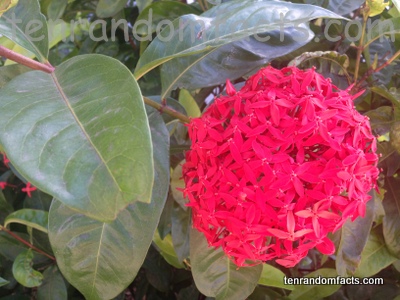You will be able to notice an Ixora in even the darkest parts of a jungle.
- Ixora is a group of shrubs and trees that are evergreen and produce flowers, and are mostly native to tropical parts of Asia.
- The name ‘Ixora’ is a genus name, and it is from the family Rubiaceae, the family of madder and coffee, while commonly grown species in the genus include Ixora coccinea and Ixora chinensis.
- ‘Ixora’ is the common name of a number of species from the genus with the same name, and they are also known as ‘flame-of-the-woods’, ‘jungle flames’, ‘West Indian jasmine’, and ‘jungle geraniums’.
- The height of Ixora plants grow from 0.6 to 3.6 metres (2 to 12 feet), depending on the species, and they typically have glossy, mid to dark green leaves.
- The flowers of Ixora have a tube-like appearance with four petals, and grow in groups of up to 60 in a cluster; and after flowering, the plant often produces red, to dark purple or black berries.
- Ixora flowers commonly bloom throughout the year in tropical areas, and they come in an assortment of colours including a range of white, pink, yellow, orange, and red shades.
- There are more than 500 species of Ixora, and numerous varieties, and some species have been used as part of traditional medicine, while others have a tendency to have invasive roots.
- Ixoras grow best in well-drained acidic soil, located in full sun, and if they are grown too close to concrete, the soil can become too alkaline, causing the leaves to turn yellow.
- Ixora will fail to flower on the occasion that light levels are insufficient, and the plants prefer warm temperatures.
- Ixora are commonly used for ornamental purposes, including bonsai and hedges, or individual specimens in the garden.






why are my leaves turning black
there are bugs attack which is washable also a black spots that are not washable no enough nutrient or nematodes attack on the roots.s